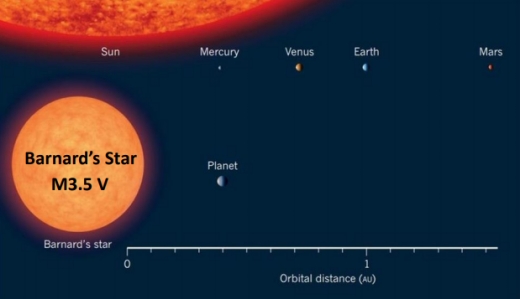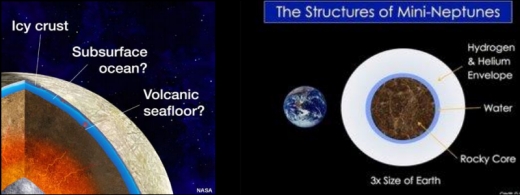Barnard’s Star b, the planet announced last November around the second nearest star system to the Earth, has been the subject of intensive study by an international team led by Ignasi Ribas at the Institute of Space Studies of Catalonia (IEEC), and Institute of Space Sciences (ICE, CSIC). As announced at the recent meeting of the American Astronomical Society in Seattle, the work helps to refine the age of Barnard’s Star and examines its potential for supporting life on its known planet.
We don’t know whether there are other planets around Barnard’s Star, but the fact of Barnard Star b’s existence is significant, according to Scott Engle (Villanova University), who along with colleague Edward Guinan presented the results in Seattle. Says Engle:
“The most significant aspect of the discovery of Barnard’s Star b is that the two nearest star systems to the Sun are now known to host planets. This supports previous studies based on Kepler Mission data, inferring that planets can be very common throughout the galaxy, even numbering in the tens of billions.”
Indeed, the idea of at least one planet around every star gains currency, and in terms of our own position in the cosmos, it bears noting that many stars in our stellar neighborhood are far older than our own. On that point, the new work benefits from the running analysis performed by a Villanova program called Living with a Red Dwarf, which homes in on the radiative environments that planets around such stars would be subject to as their host evolves. The goal is to make a determination of the likelihood that complex molecules can form, and whether life can evolve.

Image: Model of the Barnard’s Star planet system (from Ribas et al. 2018) compared to the inner Solar System. Barnard b orbits at 0..404 AU from its M3.5V host star and has an equilibrium temperature of T=-168C° in its 233-day orbit. Credit: Edward Guinan, Scott Engle / Villanova University.
The gathering of photometric data on Barnard’s Star under this project goes back to 2003, determining a rotation period of 142±8 days, a value that agrees well with other recent studies. The team then used the rotation period to extract a likely age of 8.6 billion years. Estimating stellar age for low-mass stars through rotation is a field known as gyrochronology, one that has accumulated a significant history of published analysis in the past decade. The age determined here also fits other age indicators to establish a result with 1.2 billion years play on either side.
As to that interesting planet, Barnard’s Star b is a super-Earth orbiting far enough from the primary to be cold (-168 C°), with only about 2 percent of light relative to the Earth. What the researchers go on to point out in their presentation is that as a super-Earth with a minimum mass of 3.25 Earth masses, Barnard’s Star b could have a hot iron/nickel core with resulting geothermal activity. The potential, if water is present, is for liquid water under an icy surface.
Geothermal heating could support “life zones” under its surface, akin to subsurface lakes found in Antarctica,” Guinan said. “We note that the surface temperature on Jupiter’s icy moon Europa is similar to Barnard b but, because of tidal heating, Europa probably has liquid oceans under its icy surface.”
We can only speculate about such matters, and the range of outcomes depending on the mass of the planet is wide. Note the range of possibilities in the authors’ presentation, called “X-Ray, UV, Optical Irradiances and Age of Barnard’s Star’s New Super Earth Planet – ‘Can Life Find a Way’ on such a Cold Planet?”:
Although little is definitely known about geomagnetism of superearths like Barnard b, a large liquid iron core, that could strong generate geomagnetic fields, could offer protection from strong winds and coronal mass ejections when the star was young & magnetically active. However, if the mass of the Barnard b is much higher than about 7–10 M?, its higher gravity could result in it retaining a thick H2 -He atmosphere and thus be a dwarf gas giant (mini-Neptune). In this case all hope for life is probably lost unless by chance Barnard b hosts an icy moon (with a subsurface ocean) that could be tidally heated like Europa.

Image: (L) Possible model of Barnard b based on geothermal heating. If water is present, geothermal heating could create a subsurface ocean where primitive life could exist. The model would be a scaled-up Europa. (R) In another scenario if the mass of the exoplanet is > 7 M?, then the stronger gravity could cause the retention of its primordial H2/He atmosphere. These planets are known as Mini-Neptunes / Dwarf Gas Giants. Credit: Edward Guinan, Scott Engle / Villanova University.
To learn more, we need to image the planet, an observation that would tell us about its atmosphere, surface and potential for life. On this score, the news is promising. Barnard’s Star b has an angular separation from its host that is much larger than Proxima b from Proxima Centauri, and may well be imaged by the next generation of extremely large telescopes (ELTs). It may also prove a target for the James Webb Space Telescope or the WFIRST mission.
For more, see Toledo-Padrón, “Stellar activity analysis of Barnard’s Star: Very slow rotation and evidence for long-term activity cycle” (preprint), which includes the high-precision photometry data of Barnard’s Star used in this analysis.



Something I have been trying to find is an article about the early stages of stars life. The interesting part about it was the length of time a M Dwarf was emitting more energy in early life plus the amount of hard radiation emitted. If I remember correctly it was in the billions of years time scale.
Paul something else that would be nice is a complete list of all the great CD articles with some indexing for what is referenced in them from the beginning of this site. Considering how current and in depth the reports are, it would be equivalent to a hitchhikers encyclopedia to the universe!
I assumed all along a CD was being compiled from day to day…
People pay $250.00 for nine years of X-files…
Why not that much for these past years…
If I was a rich man I’d pay for an audio books of each month of post and their comments…What a birthday present for those going almost deaf…and who just don’t read much anymore…the eyes get tired as time goes by…but the ears go on and on and on…
Thanks for this vote of confidence, James, and also Michael for the previous comment. I wish my software had a better search function, but that’s at least one window into the various discussions. As for audio, a wonderful thought. I wouldn’t mind having that myself.
Michael I would try reading the Wikepedia article entitled ” Main Sequence” . It’s a comprehensive, well referenced introduction to stars and their evolution.
Although low mass stars have a long contraction phase and can be very luminous in the beginning the radiation spectrum is important as well. UV can destroy not only water but organics as well so needs to be taken into account.
https://astro.uni-bonn.de/~nlanger/siu_web/ssescript/new/chapter8.pdf
Well that’s interesting, let see my first exposure with stellar evolution was some 57 years ago when a Jewish boy told me about his brother learning about red giants and the sun being a dwarf star, I was 8 at the time. By the time I was 12 probably one of the best guides at the time was a group of ten 20 page booklets in a boxed set that I particular enjoyed because it was well illustrated and gave me good comprehension of stellar evolution.
Now what I was referring to in the above comment is an arXiv paper that was online in the last year relating to the early life in stars with the extended period that red dwarfs are very luminous and with the information on UV and X-ray intensities in that period. Anyone remember?
Barnard’s has a interesting apparent magnitude in the K Band of the near infrared of 4.5, should make it a great target for the JWST.
You know when your an out fart when you have to make a stink every so often. :-)
I can’t remember the exact post , but I think the the article you allude to was “The Habitable zones of pre-main sequence stars” – appearing in the arXiv, Dec 2014 . It was referenced by co-author, Ramses Ramirez, in a related discussion thread .
Thank you, chasing the authors brought up a number of CD reports dealing with this subject. Paul or Ashley can you see if the authors may be or are planing to do a study of Barnard’s star and planet b since this seems to be right up their research alley?
https://centauri-dreams.org/2018/09/07/extending-the-habitable-zone/
https://centauri-dreams.org/2018/08/20/the-prevalence-of-water-worlds/
https://centauri-dreams.org/2018/08/03/revising-the-classical-habitable-zone/
https://centauri-dreams.org/2018/05/11/the-habitable-zone-the-impact-of-methane/
https://centauri-dreams.org/2017/02/28/a-volcanic-view-of-the-habitable-zone/
The only problem is that they do not talk about the UV or X-rays in their studies so there must be other papers out there dealing with this same subject.
For those interested in more details about the discovery of Barnard’s Star b and some historical background on the search for planets in this system, you might want to check out the following article:
https://www.drewexmachina.com/2018/11/16/our-new-neighbor-orbiting-barnards-star-details-historical-background/
Something that Alex Tolley might have some more information on, that I was not aware of, is the effect of infrared, UV and X-rays on plants, fungi and animals. It seems that the supposed hard radiation emitted from red dwarfs and even infrared light would do terrible things to life, but that’s not what scientific research has shown.
STIMULATIVE EFFECTS OF X-RAYS ON PLANT GROWTH’
http://www.plantphysiol.org/content/plantphysiol/8/2/287.full.pdf
https://www.researchgate.net/profile/Katja_Karppinen/publication/267743651/figure/fig3/AS:273669729550365@1442259356390/The-spectrum-of-solar-radiation-reaching-from-gamma-rays-to-radio-waves-with-closer-view.png
https://www.researchgate.net/profile/Katja_Karppinen/publication/267743651/figure/fig2/AS:273657364742173@1442256408787/Proposed-mechanism-for-signaling-pathway-affecting-flavonoid-biosynthesis-under-UV-B.png
Mutation Induction: creating novel genetic diversity using radiation.
http://www-naweb.iaea.org/nafa/pbg/mutation-induction.html
Footprints of the sun: memory of UV and light stress in plants.
https://www.frontiersin.org/articles/10.3389/fpls.2014.00474/full
Do Fungi Feast on Radiation?
https://www.scientificamerican.com/article/radiation-helps-fungi-grow/
Radiotrophic Fungi Feeds on Gamma Radiation.
http://awesci.com/radiotrophic-fungi-feeds-gamma-radiation/
Radiotrophic fungus.
https://en.wikipedia.org/wiki/Radiotrophic_fungus
Mushroom cap and shield: Using fungi to protect against radiation.
https://news.usask.ca/articles/research/2017/mushroom-cap-and-shield-professor-uses-fungi-to-protect-against-radiation.php
Lightning really does make mushrooms multiply
https://phys.org/news/2010-04-lightning-mushrooms.html
Under the Right Conditions, Humans Can See Infrared.
https://io9.gizmodo.com/under-the-right-conditions-humans-can-see-infrared-1665448040
So it seems that red dwarfs may be an ideal place for life to form and evolve, since life here on earth has had no problem with finding ways around the deadly radiation! The land area some 45 degrees to 90 degrees from solar noon on an earth size planet may have atmospheric shielding from the hardest direct radiation. This could be an area the size of the earth’s continents! The giant mushrooms will protect the animals too. ;-}
RV’s of Barnard’s Star b may have been detected in the near infrared(google @Sharonxuesong). If so, CONFIRMATION may be possible in the VERY NEAR FUTURE!